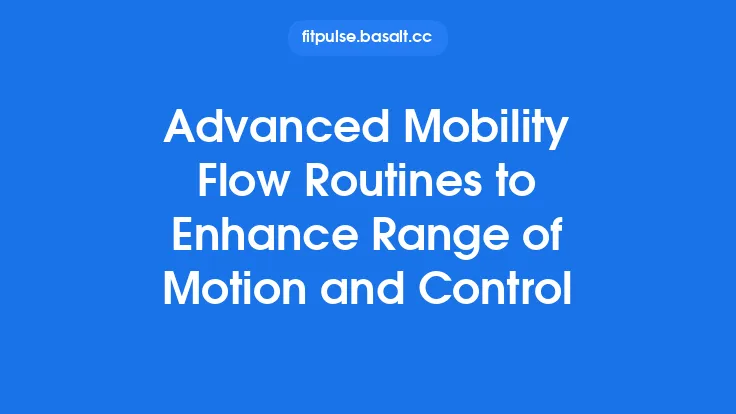Sitting for prolonged periods creates a cascade of physiological changes that extend far beyond the familiar complaints of a sore lower back or stiff neck. When the body remains in a relatively static posture, muscle fibers gradually lose their ability to contract efficiently, synovial fluid circulation within the joints diminishes, and the autonomic nervous system shifts toward a more sympathetic (stress‑dominant) state. Over time, these shifts manifest as reduced joint range of motion, impaired proprioception, and a pervasive sense of fatigue that can erode both productivity and overall well‑being.
The good news is that mobility—defined as the capacity of a joint to move through its full, pain‑free range of motion under control—can be systematically restored, even while remaining at a desk. By employing a series of purposeful, biomechanically sound movements that respect the constraints of a typical office environment, professionals can counteract the deleterious effects of sitting, improve circulation, and re‑engage the neuromuscular system without sacrificing work output.
Understanding Sitting Fatigue and Its Impact on Mobility
Physiological mechanisms
- Muscle length‑tension alterations – Hip flexors, hamstrings, and the thoracic extensors adopt a shortened state, while the gluteal complex and deep spinal stabilizers become lengthened and under‑activated.
- Joint lubrication decline – Synovial fluid production is activity‑dependent; static loading reduces the shear forces that promote fluid exchange, leading to increased joint stiffness.
- Vascular stasis – Prolonged compression of the femoral veins and reduced calf muscle pump activity impede venous return, contributing to lower‑extremity swelling and a feeling of heaviness.
- Neural fatigue – Continuous low‑level activation of postural muscles leads to motor unit desynchronization, diminishing proprioceptive acuity and increasing the perception of effort during even modest movements.
Why mobility matters
Restoring joint range and muscle activation re‑establishes optimal length‑tension relationships, improves synovial fluid dynamics, and re‑stimulates the muscle pump that drives venous return. Collectively, these changes mitigate the subjective fatigue that builds up during a typical eight‑hour workday.
Core Principles of Desk‑Friendly Mobility
- Controlled, multi‑planar movement – Mobility is most effective when joints travel through all three anatomical planes (sagittal, frontal, transverse) rather than isolated, unidirectional motions.
- Progressive overload of range – Gradually expanding the end‑range of a movement (e.g., increasing hip external rotation depth) encourages tissue adaptation without provoking strain.
- Neuromuscular re‑education – Emphasizing quality of movement—smooth, deliberate, and coordinated—re‑trains the central nervous system to recruit appropriate motor units.
- Time under tension vs. static hold – Dynamic mobility (continuous movement) promotes circulation, whereas brief static holds at the end of a range enhance joint capsule pliability.
- Integration with breathing – Coordinated diaphragmatic breathing supports intra‑abdominal pressure, stabilizing the spine and facilitating deeper joint excursions.
Designing a Structured Mobility Routine
Frequency and duration
- Daily micro‑sessions: 2–3 blocks of 4–6 minutes each, spaced throughout the day (e.g., mid‑morning, post‑lunch, late afternoon).
- Weekly progression: Add one additional set or increase the range of motion by ~5 % each week, monitoring comfort levels.
Session architecture
- Preparation (30 s) – Seated diaphragmatic breathing to prime the nervous system.
- Joint activation (1 min) – Low‑intensity, high‑frequency movements targeting the ankle, hip, thoracic spine, and wrist.
- Dynamic mobility (2–3 min) – Multi‑planar sequences that combine flexion/extension, abduction/adduction, and rotation.
- End‑range hold (30 s–1 min) – Gentle static stretch at the newly achieved range, emphasizing relaxation.
Safety considerations
- Maintain a neutral spine throughout; avoid excessive lumbar flexion or extension.
- Perform movements within a pain‑free envelope; any sharp or radiating pain warrants immediate cessation.
- Use a stable chair with a non‑slipping seat surface to prevent unintended shifts.
Key Mobility Exercises for the Lower Body
| Exercise | Primary Joint(s) | Movement Pattern | Execution Cue |
|---|---|---|---|
| Seated Hip CAR (Controlled Articular Rotation) | Hip (flexion/extension, internal/external rotation) | Slow, segmented rotation through full range | Sit tall, place a small towel under the thigh for support. Begin with 5 ° of external rotation, pause, add 5 °, repeat until maximal comfortable rotation is reached. |
| Ankle Dorsiflexion Rockers | Ankle (dorsiflexion/plantarflexion) | Repetitive rocking while keeping the heel on the floor | Keep the forefoot relaxed; focus on pulling the tibia over the foot rather than merely pointing the toes. |
| Seated Hamstring Mobilizer | Knee (flexion/extension) & hip (extension) | Alternating knee lifts with a slight hip hinge | Engage the core, hinge at the hips just enough to feel a gentle stretch in the hamstrings, then return to neutral. |
| Hip Adductor Squeeze | Hip (adduction) | Isometric contraction of the inner thigh muscles | Place a small pillow between the knees, gently squeeze for 5 seconds, release, repeat. |
| Calf Pump with Toe Extension | Ankle (plantarflexion) & metatarsophalangeal joints | Alternating calf raises with toe spreads | Perform a slow calf raise, then spread the toes wide, hold 2 seconds, and lower. |
Progression tip: After mastering the basic range, incorporate a light resistance band around the thighs for the Hip CAR or Hip Adductor Squeeze to increase muscular demand while preserving joint mobility.
Upper Body and Joint Mobility Without Leaving Your Desk
| Exercise | Primary Joint(s) | Movement Pattern | Execution Cue |
|---|---|---|---|
| Thoracic Spine Windmill | Thoracic vertebrae (rotation, lateral flexion) | Seated rotation with simultaneous lateral bend | Keep the pelvis stable; rotate the upper torso toward the back of the chair while reaching the opposite hand toward the opposite knee. |
| Scapular Retraction/Protraction Cycle | Scapulothoracic articulation | Controlled push‑away and pull‑in of the shoulder blades | Imagine trying to pinch a pencil between the shoulder blades (retraction) then pushing the elbows forward (protraction). |
| Wrist “Figure‑Eight” Mobilizer | Wrist (flexion/extension, radial/ulnar deviation) | Draw a figure‑eight in the air with the hand | Keep the forearm relaxed; move the hand slowly to trace the shape, emphasizing smooth transitions. |
| Finger “Spider” Extension | Metacarpophalangeal joints | Sequential finger extension and flexion | Starting with the thumb, extend each finger fully, hold 1 second, then flex back; repeat in reverse order. |
| Seated Cervical Articular Rotation (CAR) | Cervical spine (rotation) | Small, controlled head turns within a pain‑free range | Initiate movement from the neck, not the shoulders; pause briefly at each end of the range. |
Note: Although the article avoids overlapping with “Neck and Shoulder Mobility Hacks,” the above exercises are presented as part of a comprehensive whole‑body routine, emphasizing joint health rather than isolated symptom relief.
Incorporating Breathing and Neuromuscular Activation
- Diaphragmatic Breath‑Coupled Mobilization – Pair each major joint movement with a breath cycle: inhale to prepare, exhale to move through the range, inhale to reset. This synchrony enhances intra‑abdominal pressure, stabilizing the lumbar spine and allowing deeper joint excursions.
- Motor Unit Recruitment Warm‑Up – Before the dynamic segment, perform a 30‑second “muscle‑wake” sequence: rapid ankle pumps, quick shoulder shrugs, and light wrist flicks. This primes the nervous system, improving coordination during the subsequent mobility work.
- Proprioceptive Feedback – Use tactile cues (e.g., lightly touching the thigh while performing a Hip CAR) to heighten body awareness. The added sensory input reinforces correct joint alignment and reduces compensatory patterns.
Progression, Monitoring, and Adapting the Routine
- Quantitative tracking: Record the angular range achieved in each CAR exercise using a goniometer app or a simple visual estimate (e.g., “can rotate 30° further than last week”).
- Qualitative self‑assessment: Rate perceived fatigue on a 0–10 scale before and after each session; a gradual decline indicates improved circulation and neuromuscular efficiency.
- Periodization: Implement a 4‑week micro‑cycle—Weeks 1‑2 focus on technique and baseline range, Weeks 3‑4 introduce light resistance or increased hold times.
- Individualization: Adjust the volume based on ergonomic constraints (e.g., tighter office spaces may limit the amplitude of thoracic windmills). For individuals with hypermobility, emphasize control over maximal range to avoid joint strain.
Common Pitfalls and How to Avoid Them
| Pitfall | Consequence | Mitigation |
|---|---|---|
| Rushing through movements | Reduced joint lubrication, increased risk of strain | Adopt a tempo of 3‑2‑3 seconds (3 s eccentric, 2 s hold, 3 s concentric). |
| Excessive static holding | Muscle fatigue, decreased blood flow | Limit static holds to ≤ 30 seconds unless specifically targeting capsule pliability. |
| Neglecting core stabilization | Compensatory lumbar flexion/extension, lower back stress | Engage the transverse abdominis (draw the belly button toward the spine) throughout each exercise. |
| Performing movements with a slouched posture | Impaired thoracic mobility, forward head posture | Keep the scapular plane open; imagine a string pulling the crown of the head upward. |
| Skipping the breathing component | Diminished intra‑abdominal pressure, reduced movement efficiency | Pair each movement with a full diaphragmatic breath cycle. |
Integrating Mobility into Workplace Culture
- Leadership endorsement: Managers can model the routine during brief “mobility huddles,” normalizing the practice.
- Visual prompts: Place discreet signage near workstations reminding employees of the “3‑minute mobility reset.”
- Digital reminders: Use calendar invites or productivity apps that trigger a gentle chime at pre‑set intervals, prompting the next mobility block.
- Data‑driven feedback: Encourage employees to log their mobility metrics in a shared spreadsheet, fostering a sense of collective progress.
By embedding these practices into the fabric of daily work life, organizations not only mitigate sitting fatigue but also cultivate a culture of proactive health stewardship.
Resources and Tools for Ongoing Success
- Mobile apps: Look for platforms offering customizable timers, goniometer overlays, and breathing guides (e.g., “Mobility Coach” or “BreathSync”).
- Portable equipment: A lightweight resistance band, a small foam roller, or a compact yoga block can expand the repertoire of desk‑friendly movements without encroaching on office space.
- Educational webinars: Periodic virtual workshops led by physiotherapists or ergonomics specialists can refresh technique and introduce advanced progressions.
- Scientific literature: Staying abreast of emerging research on sedentary behavior, joint health, and neuromuscular activation ensures the routine remains evidence‑based.
By systematically applying these desk‑friendly mobility routines, professionals can counteract the insidious fatigue that accompanies prolonged sitting, preserve joint health, and sustain high levels of cognitive and physical performance throughout the workday. The approach is evergreen—rooted in fundamental biomechanics and adaptable to evolving workplace environments—making it a lasting pillar of any comprehensive ergonomic strategy.





